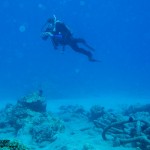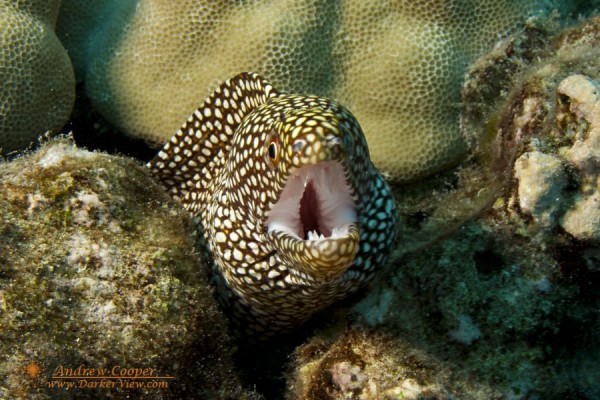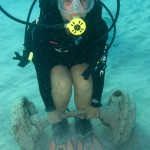A perfect blue day at Māhukona, in a word… Idyllic.

When you want to see the stars, find someplace dark
Heading north from Kawaihae there is some of the best diving in the islands. Most of the sites along this rugged coast northern are best dived from a boat. You can reach many from shore, but access can be tricky and a matter of knowing which 4WD road will get you to a usable put in point. There are a couple exceptions where access is easy, the best is Mahukona.
What you find here is a small port from the days when sugarcane and cattle were transported on small steamships that plied the waters up and down the Hawaiian Islands. A substantial pier and other facilities were built in a small cove to serve the north end of the island. A railway terminated here, allowing products to be brought in from much of North Kohala. Most of that is gone now, replaced by good roads, semi trucks and the large port at Kawaihae. What is left is a sleepy little cove with perfect water and great diving.

A steel ladder at the top of the wharf provides access right into the water. The access is simply the easiest I have ever used on a shore dive. No sand, no slippery rock, simply a parking lot at the waters edge!
Once you leave the pier head for the center of the harbor. You will quickly find several heavy mooring chains. Large and obvious these chains are heavily encrusted with coral, simply follow them out to the wreck of the Steamship Kauai. The wreck lies in 12-24 feet of water at the center of the harbor.
The engine and propeller are the largest parts to be found and are a little to the north of the large sandy area at the center of the cove. The propeller is in only about 12-15ft of water, accessible to snorkelers as well as divers. Connected to the propeller by the shaft is the large steam engine. This is less obvious when you first see it, but hard to miss once you know what it is. Closer inspection will show numerous pipes, control linkages and the large flywheel at the rear of the engine. Looking into the engine you can see the crankshaft and the numerous fish that find the engine a perfect hangout. Spend some time here, we have found a dwarf moray, blue dragon nudibranch and great fish at the engine.
Scattered out from the engine is a great deal of other evidence of the wreck. The steamship had a cargo of agricultural products and railroad parts when it sank. You will find quite a few wheel sets for narrow gauge rail car use, one is under the engine, others in the middle of the sandy area just seawards of the engine. Cables, piping and ballast bricks are everywhere. A boiler can be found on the north edge of the sandy area, about 4ft in diameter and 12ft long. Check inside to see who is home.
We found three different species of moray eels here, good fish and healthy coral. Not many large fish, fishing and spear hunting is allowed in the area. The small fish area very numerous with large numbers of fry int the shallows and around the wharf.
Mahukona is just about the perfect shore dive site. Park on the pier, and just drop your gear in the water. Shallow diving unless you head out of the cove, but a lot to see in the harbor, you may never make it any further. This site makes for a long shallow dive exploring a little local history.
Yet another photo of a Whitemouth Moray on a Kohala reef. Well? they are the most common moray to be found at scuba depths. At this point I have an extensive collection of Whitemouth Moray photos. They are common, photogenic, and quite cooperative, they sit still while you take the photo.
I only found three of them in the afternoon and evening of diving…

The plan… Arrive at Mahukona in the mid-afternoon, do an afternoon dive. Then we fire up a barbeque and have dinner, talk story and watch sunset from a beautiful Hawaiian shore. When it gets dark we load up a second tank and head back out for a night dive. Not a bad plan! I have not been night diving in quite a while, so when the plan was suggested I readily agreed.
Our group contained several folks who had never dove Mahukona. Thus the afternoon dive plan was obvious, head for what remains of the SS Kauai, visiting the engine and propeller, exploring scraps of the cargo. From there we headed out onto the coral beyond, exploring the reef due west of the engine to a depth of about fifty feet. It was a nice afternoon dive, nothing particularly exciting found. I noted the behavior change in many fish, seen as the light begins to fade. While not yet dark, it was apparent that the fish were readying for night, hovering close to chosen coral heads, awaiting the coming darkness.
